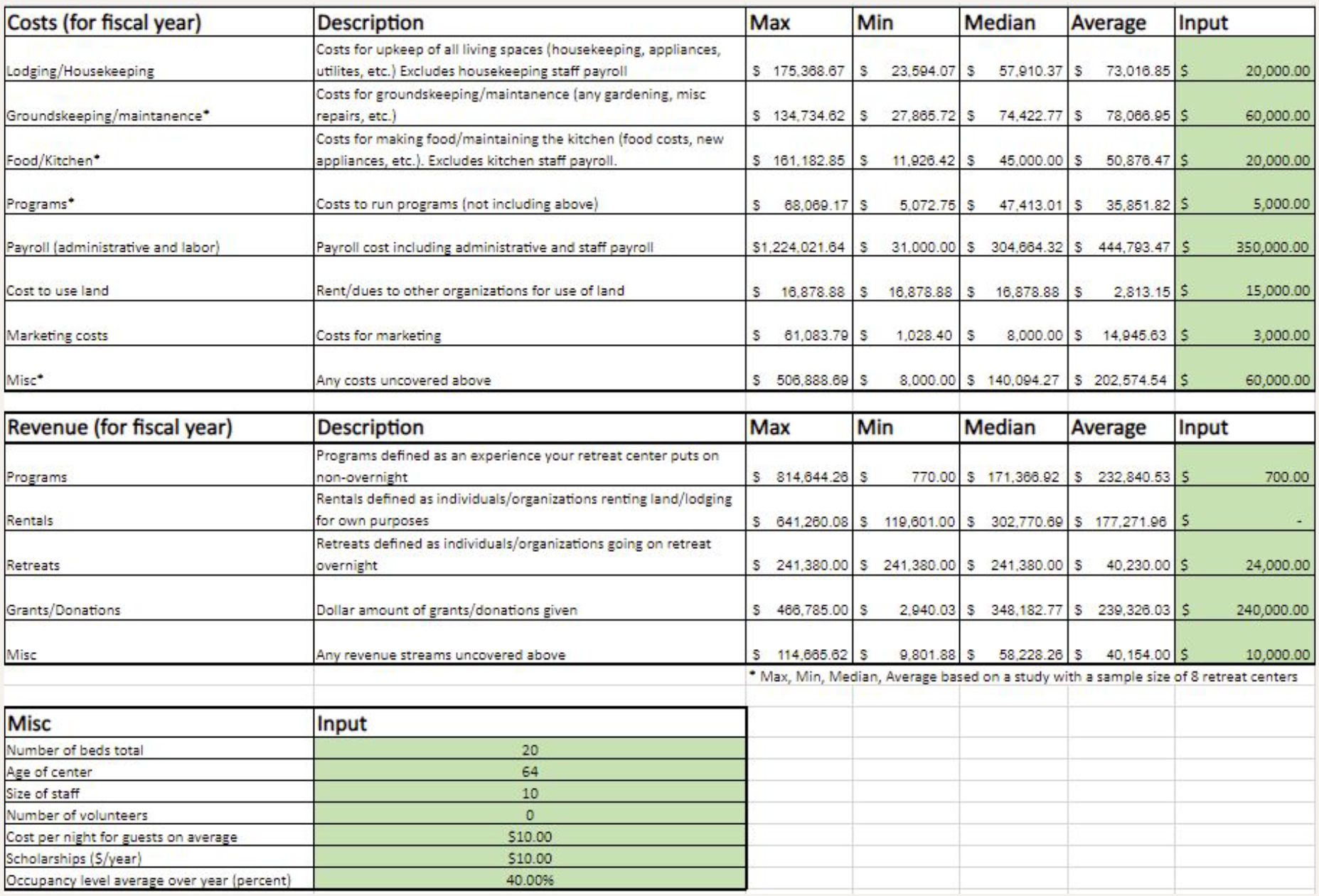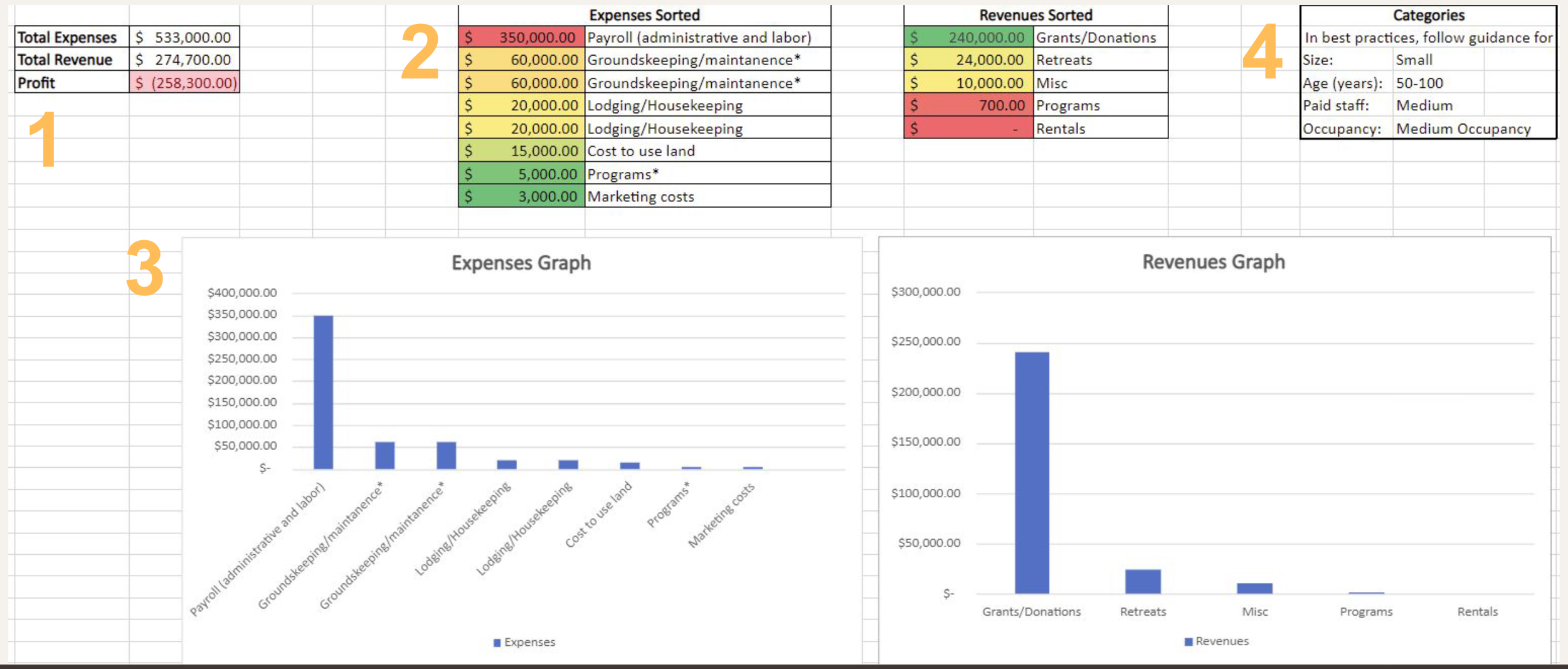Key Factors for Sustainability in Retreat Center Business Models: Cal Poly Study Update
In partnership with a team of industrial engineering students at Cal Poly University, the Retreat Center Collaboration is studying models for financial and programmatic sustainability at retreat centers. We introduced Alyza Jose, Jenna Vokolek, and Yumi Aguilar in our first post about this eight-month study, which is nearly complete. Find out what they’ve learned from their interviews, site visits, and in-depth data collection at retreat centers.
View the full meeting video by clicking above.
Or scroll down for takeaways from the conversation.
Study Overview
The study found there’s no one-size-fits-all financial model for retreat centers due to high variability between centers, budgets, and models.
The study worked with eight centers across the RCC community, and focused on studying in-person retreat centers that provide overnight stays. The centers were selected from within the RCC network to represent geographic diversity across the U.S. and Canada, budget diversity, and religious affiliation diversity. The study sample does not represent all possible models, and some centers who are newer to RCC did not have an opportunity to participate. Study participants will remain confidential.
The goals of the study were to:
Identify and quantify the most influential variables that impact retreat center financial performance and sustainability
Improve ongoing financial visibility to support better decision-making
Develop operational and programmatic models to help retreat centers reach long-term sustainability and profitability
The Current State of Retreat Centers
Across all eight centers participating in the study, the highest cost was payroll, followed by miscellaneous costs, which varied widely from center to center.
Four major sources of revenue contributed almost equally to retreat centers’ bottom lines: programs, rentals, overnight retreat stays, and donations/grants.
Despite the global wellness tourism sector projecting growth of 9.9% between 2022 and 2030 (see the literature review), this study shows significant annual deficits across the majority of study participants.
Three of the eight participating centers were financially sustainable, with an average annual gain of 8.2%.
Centers experiencing loss had an annual average deficit of 18.7%.
Overall, retreat centers in this study show an average annual deficit of 7.21%.
Key Areas of Impact Across All Retreat Center Models
The study focused on four key areas in various retreat center models—foundation, payroll, accommodation, and programming—and the impact these areas had on center sustainability.
Foundation refers to the core elements that make up a center’s identity. The study found:
Religious affiliation doesn’t impact financial sustainability. There were similar deficits across retreat centers, regardless of religious affiliation.
While vague mission statements allow for more flexibility in programming and possible revenue streams, more tailored statements give the center a stronger sense of brand identity.
Center location can affect the bottom line: Who offers services similar to your own in the area? Who are the people or groups in the area you can reach out to for engagement? Could you partner with the National Park Service to help with land maintenance?
Payroll was the highest cost across all centers. The study focused on options for building out revenue, not changing current compensation structures. It can be complicated and time consuming to change a payroll system, and the study aimed to protect worker compensation in an economy where many are already struggling. Suggestions for building out revenue included:
Partner with local community organizations or service groups for volunteers to support housekeeping, maintenance, and the like.
Provide onsite living accommodations for administrative staff as a component of your compensation package, or offer other perks that are clearly quantified to ensure equivalent compensation.
Accommodation - There’s a long-held belief in the sector that a retreat center needs fifty beds to be sustainable. The study found there is no ideal or minimum bed count. A retreat center with 200 beds has the same percent loss as a center with less than fifty beds. Other considerations include:
There is a greater push for less-communal accommodations post-pandemic. Private bedrooms and restrooms are also important if your center is considering corporate retreats.
Encouraging longer-term stays with discounts can help cut down on housekeeping costs.
Programming isn’t being utilized to its fullest potential.
Currently, less than 15% of retreat center revenue comes from programming.
The financially sustainable centers in this study all utilize youth-focused programming.
Corporate retreats are a large and under-utilized demographic, particularly in an era of remote work. Many companies are willing and able to pay high prices to convene their teams in a natural setting. While there are legitimate concerns related to maintaining your center’s nonprofit status, this revenue could help your center offset your other costs.
Centers that serve underserved communities (and want to keep costs low for those communities) would benefit from supplementing their programming with corporate retreats, weddings, or other offerings. It would take about five overnight corporate retreats to offset the average annual deficit.
Offering programs and hosting retreats that aren’t 100% in line with your center’s mission doesn’t detract from your mission—it allows you to keep providing the rest and healing people need.
The True Cost Calculator Tool & Best Practices Manual
Since there is no one-size-fits-all financial model for retreat centers, the study developed a tool and manual to help leadership make informed financial decisions.
The true cost calculator tool features a model budget based on study data. Entering your center’s financial data in the green columns of the Excel worksheet allows the tool to export highlights of your budget’s weak spots, and identify key areas where your retreat center may be losing money.
The output sheet sorts and totals the information into four areas:
The first area is your profit margin. This is a simple totaling of revenue, expenses, and the difference between them.
The second area sorts your expenses and revenue, color-coded like a traffic light. Red cells reflect high costs or low revenue, and encourage you to make adjustments. Green cells reflect low costs or high revenue, and encourage you to stay the course.
The third area graphs your expenses and revenue in a simple bar chart.
The fourth area categorizes your center and points you toward best practices. The best practices manual provides relevant recommendations based on your center’s categories.
You can see a sample of the true costs calculator tool here. This is not a working copy. The working copy will be ready by July 2023.
The best practices manual will go hand-in-hand with the calculator tool. Output from the calculator tool can be taken to the best practices manual for advice on how to address any shortfall. The manual is not yet complete, but will be ready by July 2023.
The Potential for Future Study
This study could expand into future projects. The current study adopted a very systems-based approach, but a lot of retreat center work is not very systems-based. While it can be challenging to incorporate the more qualitative aspects of retreat center work, a future student research team could look into those aspects in more detail.
This work is more than a typical manufacturing or engineering project—messier, but in a good way.
Change management could be another area for the study to branch into. Change can be intimidating, but necessary for retreat centers to truly thrive. Finding ways to help current leadership adapt to the shifting times is key—and it will start with leaders who connect deeply with the people they want to serve.
Notes and Audio
Follow the link below to access PDFs, audio, and additional meeting notes.
Join the Discussion
Do you work at a retreat center? Would you like to connect with the RCC community for more insights and support? Find out about our upcoming events.
Attend our next Community Call by subscribing to our mailing list.
Join our private Facebook group to connect with other retreat center professionals, learn, share, collaborate, and socialize together.



